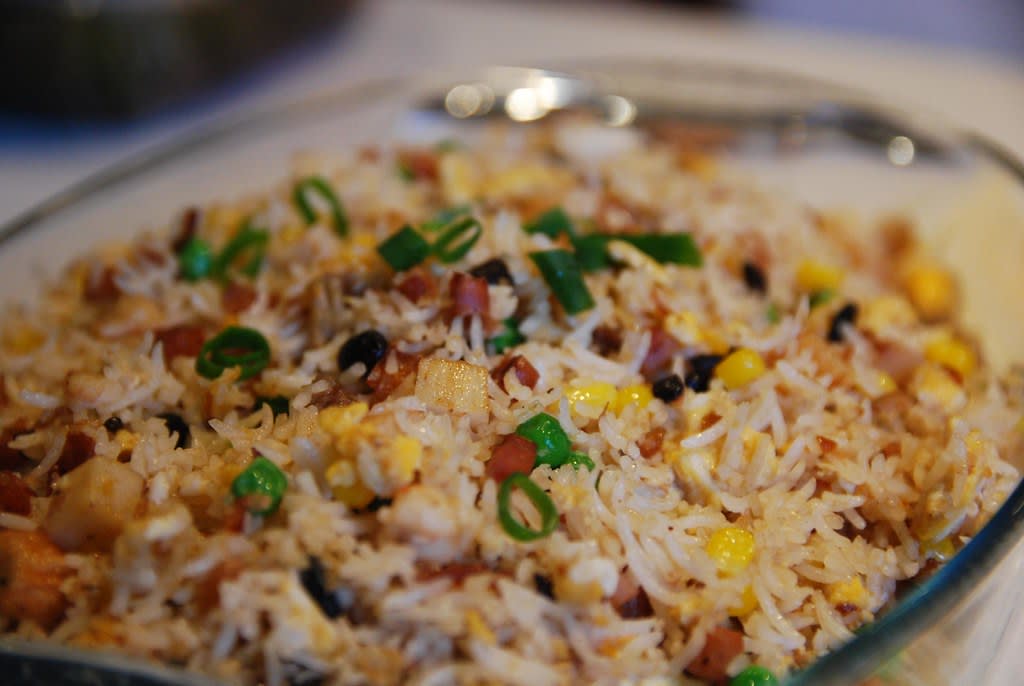Fried Rice
A Family Staple

As I greeted my grandparents in the soft lights of their kitchen, I felt the familiar embrace of the old house. Though the kitchen changed with innovations since the lighthearted days of my youth, it still regulated a firm place in my memory. Every nook and cranny, every organized shelf of candy, every indelible detail even more intrinsically memorized than the houses we moved through. What’s the saying? If only walls could talk. What was missing as I scanned the counter tops and stove was the fried rice. Fried rice - though not an immediately obvious family recipe considering I am a white woman from the suburbs of Sacramento – has come to define the table of my grandparents. Even better as leftovers, this aromatic favorite never failed to see a birthday, holiday, wedding, or casual get-together. It barely registered as a possibility that it, in fact, would not be on the menu. After moving back home from Berkeley upon graduating, my grandfather had tried recipe after recipe from the cookbooks they owned, starting with his interest in Asian cuisine. It was new, even for him, as he had always had an interest in cooking. He was an architectural intern, and another draftsman in his office had given him tips on a drier version of fried rice, having been from Thailand. These tips are the foundations of the version my grandfather uses to this day. As he experimented, he realized that soy sauce becomes saltier over time, rather than sweet as it is brand new. This meant the age and moderation of the soy sauce used is critical to the desired overall taste. While I’ve attempted fried rice myself, although delicious, it never compares to the symphony of flavors my grandfather’s fittingly constructs. Building upon his foundation over the years, he has fashioned his recipe painstakingly into the monument it has become. Only appropriate for an architect, I guess. I give a slight sigh, glancing back up to my grandfather smiling down at me, contentedness beaming from his gaze. This turns inquisitive as he wonders “what’s the matter?” I shake my head, wanting to change the subject to my upcoming transition to college.
“It just feels weird to not have fried rice for some reason,”
“I guess we’ll have to make some then,” he laughs.
- Equipment -
• Non-stick wok
• Electric rice cooker
• Large metal chef’s spoon
- Ingredients –
• 1 cup uncooked long grain white rice
• 4/5 cup cold water
• 6 strips bacon, cut into Ľ” pieces
• 2-3 tablespoons of vegetable oil
• 5 large eggs, whipped for scrambling
• 5 green onions, cut into Ľ” pieces
• Soy sauce
- Recipe -
Pour rice into a rice cooker, add water.
Long grain rice cooked with a little less water than rice creates a dry rice, not sticky. Short grain rice with greater amount of water than rice creates sticky rice. Sticky rice cannot be fried properly.
Cook the bacon in a saucepan until white fat disappears and meat is brown.
Pour out the hot fat and discard. Set the saucepan aside, on an angle to
allow residual fat to drain.
Cut the green onions. I suggest splitting the white bulb portion down the middle before cutting into Ľ” pieces.
Whip the eggs and set aside.
When the rice is cooked, unplug the cooker and stir and separate the rice while it starts to cool.
Put the oil in the wok and heat until the oil is hot.
Stir in the cooked rice until all the rice is coated with oil.
Spoon the rice back into the rice cooker bowl, which should leave only a
residue of oil in the wok.
Pour the whipped eggs into the hot wok and stir until completely dry and broken into small chunks.
Pour the fried rice into the scrambled eggs and stir until evenly mixed.
Pour soy sauce into the mixture. Not too much! Mix together. The color should be even with no liquid in the wok. Begin the soy sauce with one quick pass across the wok. I have found that
two passes is just right. Three passes leaves liquid in the wok and the fried rice is too salty. This is based on a large new bottle of soy sauce with a ˝” opening. A small. dispenser will not flow like that. Older soy sauce becomes saltier, some brand-new soy sauce is sweeter, less
salty.
Turn off the heat.
Drain the fat from the bacon again.
Stir in the bacon and the green onions.
Cover the wok until serving.
If you enjoyed this recipe, please feel free to leave a tip. Anything can help as I try to deliver all kinds of interesting content to readers. Please consider reading some of my other works, and I thank you so much for the support!
About the Creator
Kayla Bloom
Just a writer, teacher, sister, and woman taking things one day at a time in a fast-paced world. Don’t forget to live your dreams.






Comments
There are no comments for this story
Be the first to respond and start the conversation.